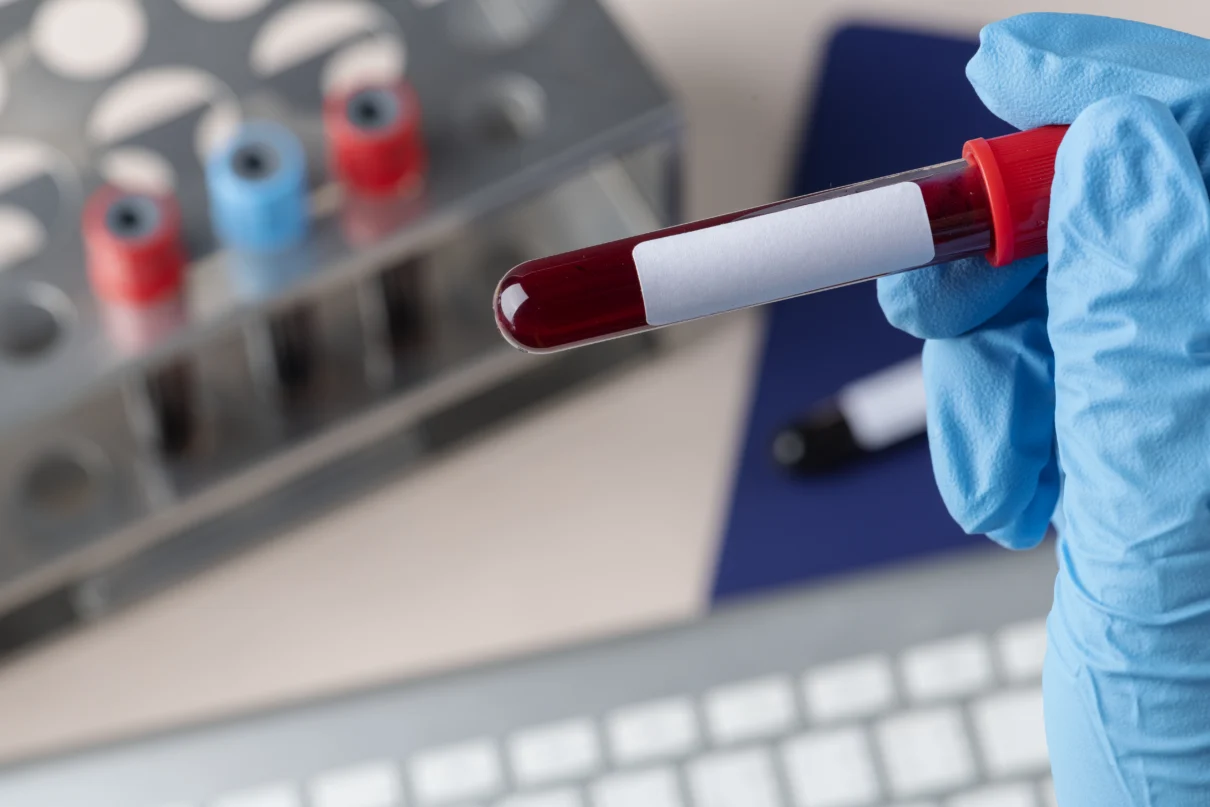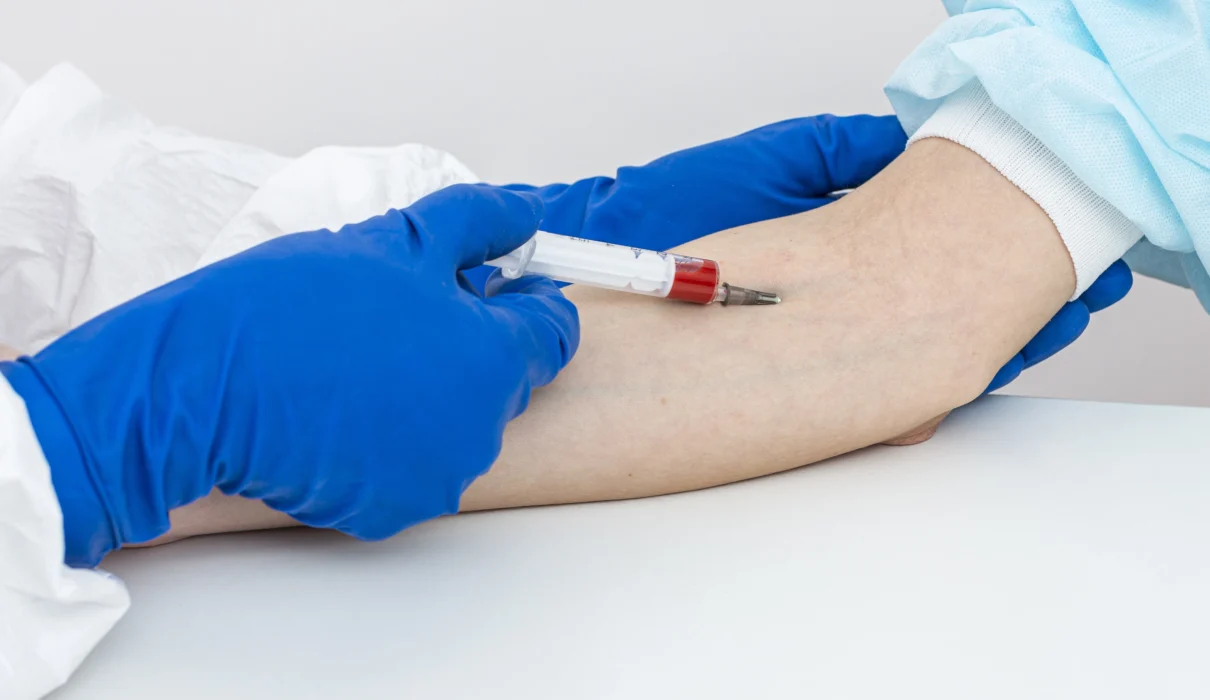(CBC) is a blood test. It’s useful in case that you need to check your overall health and find various conditions including infection, anemia and leukemia .
This test measures red blood cells which carry oxygen, white blood cells which represent the immunity, platelets which help blood to clot.
CBC test also measures hemoglobin which is the oxygen-carrying protein in red blood cells, hematocrit which represents the amount of red blood cells in the blood and mean corpuscular volume (MCV) which is a measure of the average size of your red blood cells.
The CBC is done by using primitive laboratory equipment or an automated hematology analyzer which counts cells and gathers information about their size and structure.
Sometimes, manual tests can be used to confirm abnormal results. Approximately 10–25% of samples need a manual blood smear review to verify that the analyzer results are consistent.
CBC tests have been developed overtime. In 1852, A scientist called Karl Vierordt published the first procedure for performing a blood count, this procedure involved spreading a known volume of blood on a microscope slide and counting every cell.
In 1874, the hemocytometer was invented by Louis-Charles Malassez, he made the microscopic analysis of blood cells simpler.
In the late 19th century, Paul Ehrlich and Dmitri Leonidovich Romanowsky developed techniques for staining white and red blood cells and these techniques are still used to examine blood smears.
Automated methods for measuring hemoglobin were developed more in the 1920s. Afterwards, Maxwell Wintrobe provided the Wintrobe hematocrit method in 1929, which helped him define the red blood cell indices.
A landmark in the automation of blood cell counts was the Coulter principle, which was introduced by Wallace H. Coulter in 1953. Further research in the 1970s introduced the use of optical measurements to identify and count cells, which enabled the automation of the white blood cell differential.(2)
CBC test is performed as a part of routine health check-ups. Its frequency may depend on your age and overall health status. For healthy adults, periodic CBC tests is often sufficient to be performed every 1-3 years.
Why we do CBC test?


CBC test is performed for many reasons
- To check the efficacy of medical treatment. A complete blood count can be used to keep an eye on treatment with medicines that have effect on blood cell counts and radiation.
- To check overall health. A complete blood count is a part of a medical test to examine general health and to find conditions, such as anemia or leukemia.
- To keep an eye on a medical condition. A complete blood count can be very helpful in conditions that affect blood cell counts.
- To help with diagnosis of a medical condition. A complete blood count can help health care professionals find the reason for symptoms such as fever, fatigue and weakness. It also can help with finding the reason for bleeding, swelling, pain or bruising.
- Evaluation of patient’s health.
How to prepare yourself ?
If you are asked to do the CBC test only, you can eat and drink as you usually do before the test, nothing else is required from you. But if the same blood sample also will be used for other tests, you might need to fast for a certain hour before the test. So always ask your health care provider what you need to do before the test.
For a complete blood count test, a professional member of the health care team takes a sample of your blood by putting a needle into a vein, usually, in your arm at the bend in your elbow. The blood sample then is sent to a lab to give you the results. After the test, you can return to your usual activities right away.
for what ages this test could be given?
Almost, cbc tests are given for all ages. This table clarifies the need for cbc test throughout different ages:
| Age | Why cbc test |
| Pediatrics | CBC allows the clinician to narrow the differential diagnosis and tailor the subsequent evaluation. It helps with identifying if there is infection or blood diseases. |
| Adults and Geriatrics | CBC helps with identifying if there is infection in the body.Helpful in following up the response to medications.Help with diagnosis of immunity disorders. |
(4),(5)
In what cases CBC considers necessary to be done?
In cancer cases, CBC can be used to help with diagnosis of a cancer or monitor how cancer or its treatment is affecting your body. People receiving chemotherapy often undergo regular CBCs.
In cases, CBC is used to help with diagnosis of some blood cancers, such as leukemia and lymphoma, to know if cancer has spread to bone marrow, to see how patient’s body is being affected by cancer treatment and to monitor and diagnose noncancerous conditions during cancer treatment.
CBC is used to detect, confirm, monitor or rule out a wide range of hematologic disorders, or to evaluate and manage the hematologic effects of treatments (radiation, chemotherapy, medications) or other conditions (illnesses and injuries).
In cases of anemia, CBC tests are very important. It is used to count the number of blood cells in a sample of blood. The test measures the amount of the red blood cells in the blood which is called hematocrit and the level of hemoglobin in the blood.
This test also gives information about the size, shape and color of the red blood cells.
In cases of infection, CBC tests can be used to know if there is infection in the body. When white blood cell count is higher than normal, it indicates there is infection in the body.
Also in cases of inflammation. CBC tests can point to an immune system disorder or a bone marrow disease. But a high white blood cell count also can be due to a reaction to medicines or hard exercise.
In cases of leukemia, CBC test can show leukemia if there are abnormal levels of white blood cells or abnormally low red blood cells or platelets.
What are the benefits of CBC?
A CBC test provides health care professionals with a complete overview about the blood and its components. This is the reason for being a common test.
CBC test can detect some of the most common diseases, such as autoimmune disorders, anemia, , dehydration, bone marrow disorders, inflammation, inflammation, leukemia, lymphoma, myeloproliferative neoplasms, myelodysplastic syndrome, thalassemia, nutritional deficiencies (e.g., Iron, B12 or folate), sickle cell disease and cancer that has spread to the bone marrow.
Depending on the condition, CBC results often will not tell you a diagnosis. But follow up tests are also required to be done to determine the condition correctly. This test will be helpful but with taking professional medical history and the good examination for the suspected condition.
Is this test beneficial for babies?


Yes, complete blood count (CBC) test is very beneficial for babies, especially with white blood cell differential as it can to evaluate if newborns are at risk for sepsis.
It is also beneficial for children to know how many red blood cells, white blood cells and platelets are in the blood.
It also helps with finding out the cases with infections, cancers, or blood disorders as these conditions cause changes in the number and kind of cells and proteins in the blood. Therapies and medicines can also change their blood.
Health care providers use the CBC with differential for babies to diagnose a medical problem, to tell how the child fights infection, to heck if the child has an infection, to study how a disease affects their body and if a treatment is working.
Is there a CBC for animals?
Yes, there is a CBC test for animals and it is useful for animals. Blood tests allow a doctor to determine accurately the reason for illness of animals and help with monitoring the progress of medical treatments and conditions.
A CBC test provides information on hydration status, infection, anemia, the blood’s clotting ability and the capability of the immune system to respond.
This test is important for pets which are not feeling well with some symptoms such as fever, weakness, diarrhea, vomiting, pale gums, loss of appetite, or just not feeling well in general.
If your pet will have a surgery, a CBC test can help with detection of bleeding disorders and other invisible abnormalities.
HCT/PCV (hematocrit/packed cell volume) measures the percentage of the pet’s red blood cells. This test enables doctors to detect anemia, bleeding episodes and dehydration. Its normal range in a cat is above 28 and in dogs above 35.
HGB and MCHC (hemoglobin and mean corpuscular hemoglobin concentration) are the pigments which carry oxygen of red blood cells
RETICS (reticulocytes) are new red blood cells or immature red blood cells. When they are at high levels, they indicate signs of recent bleeding or regenerative anemia.
WBD (white blood cell count) indicates the body’s immune and infection fighting cells. If there is increases or decreases in count, it indicates certain diseases such as leukemia, cancer or infections.
NEU, LYM, MONO (neutrophils, lymphocytes, monocytes) are specific types of white blood cells that fight infection. If there is an increase, it can refer to an infection or cancer.
EOS (eosinophils) are also a specific type of white blood cells. if the count is elevated, it may point to allergic or parasitic conditions.
PLT (platelet count) measures the cells that help with formation of blood clots and control bleeding.
What is the process of a complete blood count test?
For animals. Small sample of blood is collected and put into a special tube that prevents blood clotting. The sample taken is then put i7n a machine called an automated blood analyzer. This machine counts the different cell types and describes various characteristics of the cells.
In addition to that, a drop of blood is spread thinly on a glass slide creating a blood smear. This is stained with special dyes and examined under the microscope to see the appearance of individual cells.
For humans. Be certain of wearing a short-sleeved shirt or a shirt with sleeves that you can easily roll up. You can surely eat and drink normally before a CBC.
Although your doctor may ask you to fast for a specific amount of time before the test. Fasting is common if the same blood sample will be used for additional testing. The doctor will provide you with specific instructions.
During a CBC test, a lab technician or a nurse will draw blood from a vein, definitely from the inside of your elbow or from the back of your hand. The test will last only for a few minutes.
In CBC test, the technician cleans the skin at site of puncture with an antiseptic wipe, places an elastic band or tourniquet around the upper arm to help the vein fill with blood, inserts a needle in the vein and collects a blood sample in one or more specific tubes.
After that, the technician removes the elastic band, covers the area with a bandage to stop any bleeding, labels the sample and sends it to a lab for analysis.
A blood test can be quite painful. When the needle punctures the skin, people might feel a prick or pinching sensation. Some people also feel light-headed or faint when they see blood.
Afterwards, you may have a tiny bruising but it will clear up within a few days. Most CBC results are shown within a few hours to a day after testing.
For infants. In young infants, a nurse will sterilize the heel of the foot well and use a small needle called a lancet to prick the area. The nurse will then gently squeeze the heel and collect a small amount of blood in a vial for testing.
What are the results for the CBC test?
When you deliver your results, you will find two columns: a “reference range” and your results. If your results are within the reference range, they are considered normal.
If your results are higher or lower than the reference range, they are abnormal. Mild anemia is one of the most common causes for the abnormal results in your test.
Each lab has its different ways of studying the blood sample. So the reference range will depend on the lab that deals with your blood tests. It also depends on things that can affect the blood such as your sex, your age and how high above sea level you live.
Generally, the reference ranges are:
Red blood cells: 4.5 million to 5.9 million cells/mcL for men and 4.1 million to 5.1 million cells/mcL for women.
White blood cells: 4,500 to 11,000 cells per microliter (cells/mcL).
Platelets: 150,000 to 450,000 platelets/mcL.
Hemoglobin: 14 to 17.5 grams per deciliter (gm/dL) for men and 12.3 to 15.3 gm/dL for women.
Hematocrit: 41.5% to 50.4% for men and 35.9% to 44.6% for women.
Mean corpuscular volume: 80 to 96.
Is the result of the CBC test diagnosing a certain issue?
It’s important to know that the results of red blood cell count, hemoglobin and hematocrit are related because they each measure a feature of red blood cells.
- If there are lower than usual measures in red blood cell count, hemoglobin and hematocrit, it is a sign of anemia.
Anemia has many reasons such as blood loss, low levels of certain vitamins or iron or another medical condition. People with anemia might feel weak or tired. These symptoms may be because of the anemia itself or the cause of anemia. CBC test measures enable us to know the cause and type of anemia.
- When red blood cell count is higher than usual, the case is known as erythrocytosis.
- A high red blood cell count or high hemoglobin or hematocrit levels could refer to a medical condition such as blood cancer or heart disease.
- White blood cell count. A low white blood cell count indicates leukopenia. The cause may be a medical condition such as an autoimmune disorder which destroys white blood cells, bone marrow problems or cancer. Certain medicines also can lead to a decrease in white blood cell counts.
- When white blood cell count is higher than usual, it is most commonly because of an infection or inflammation.
It could refer to a bone marrow disease or an immune system disorder. A high white blood cell count also can be due to a reaction to medicines or hard exercise.
- Platelet count. When the platelet count is lower than usual, the condition is known as thrombocytopenia.
- If platelets are higher than usual, the condition is known as thrombocytosis. Either it can be a sign of a medical condition or a side effect from medicine. A platelet count that is outside the reference range will mostly lead to more tests to diagnose the reason.
Are there any risks of CBC?
There is very little risk with blood tests. You may face slight pain or bruising at the site of puncture but most symptoms go away quickly.
Some side effects also may happen, they are usually minor and happen at the site of puncture. Side effects that may happen include bleeding, swelling, discomfort or infection.


